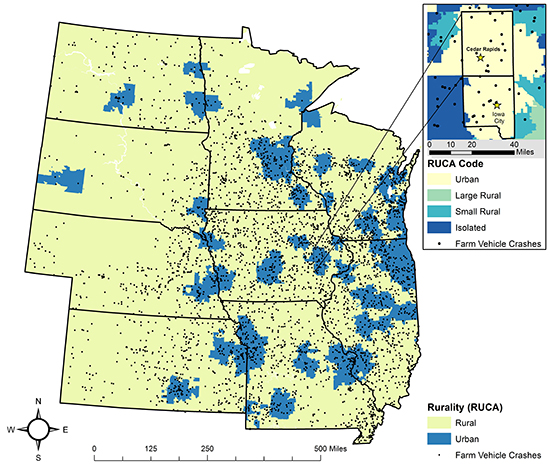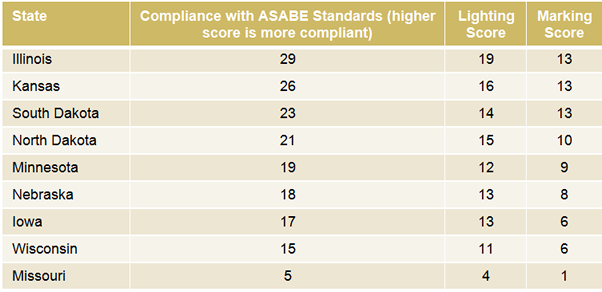Marizen Ramirez, MPH, PhD
Overview
Crashes involving farm equipment occur quite frequently in the Midwestern U.S. We know a little bit about these crashes from a handful of smaller and much older studies. Comprehensive information on current trends and intervention approaches across multiple states is needed. Our team focused on the following goals:
- Compare crash rates across nine Midwest states. Downloadable file: Farm Vehicle-Related Crash Study in Nine States 2005-2010.
- Identify the roadway and weather conditions when crashes occur, the kinds of vehicles involved in the crashes, the manner in which the crashes occur, as well as the characteristics of drivers/operators and passengers. Downloadable files: Epidemiology of Farm Equipment Crashes, Farm Equipment-related Crashed Involving Youth, and Prevalence of Alcohol Testing and Impairment in On-road Farm Equipment-related Crashes.
- Using mapping methods, describe where crashes occur. Downloadable files: Farm Equipment-related Crashes and Effect of Road Segment Characteristics on the Incidence of Farm Vehicle-related Crashes.
- Determine if a strategy, lighting and marking policies for farm equipment, prevents crashes. Downloadable file: Lighting and Marking Legislation to Prevent Farm Equipment Crashes on the Road.
Relevance
Public roads are one of the most dangerous environments, where thousands of crashes and related deaths and injuries occur each year in the United States. Farmers of both small and large operations often use public roadways to travel from field to field/farmstead and to transport goods to population centers.
Very little is known about farm equipment crashes and subsequent injuries. Despite the lack of information, efforts at the state level exist to help prevent farm equipment roadway crashes. One intervention policy approach, traffic legislation that requires lighting and marking of farm equipment, has been in place for decades with various types of laws across different states. Some work has been done to describe the laws, but no research has been conducted to evaluate if these laws actually help in reducing the risk of a farm equipment crash.
Our research advances knowledge about current trends of farm equipment crashes in nine Midwestern states, and assesses if safety policies on lighting and marking help prevent crashes.
Study Findings
Our project has now successfully accessed 2005-2010 farm equipment crash data from all nine state Departments of Transportation. During this five year period, there were more than 7,000 crashes involving farm equipment. We combined datasets and geocoded (address-matching) crash locations on maps of the region. We have also collected and analyzed the content of lighting and marking policies from all nine states, for comparison with crash rates.
- Farm equipment crashes are not just a rural problem. About 70% of crashes involving farm equipment occur in rural zip codes, while 30% occur in urban zip codes.

Crashes involving farm equipment in the Midwest region.
- Farm equipment crashes tend to occur on certain types of roads. In a unique analysis, our team was able to obtain data on about 320,000 roads in Iowa to determine what types of roads have a higher probability of having a crash. Crashes are much more likely to occur on high speed roads (over 50 MPH speed limits), roads that have high traffic density (more than an average of 361 motor vehicles per mile per day), farm to market routes, and roads with smaller lanes and smaller road widths. Road segments with a 6‐10% gradient was associated with a 40% decrease in odds of a farm vehicle crash (OR=0.60, 95% CI: 0.49, 0.75). We also found that compared to a straight road segment, a road segment with a 6-10% sinuosity (curviness) was associated with a 62% decrease in odds of a farm vehicle crash (OR=0.38, 95% CI: 0.29, 0.52).
- Stringent lighting and marking policies may reduce crashes. We compared nine states’ policies on lighting and marking farm equipment with standards offered by the American Society for Agricultural and Biological Engineers (http://www.asabe.org/). We generated a compliance score to show the extent to which each state’s policies complied with ASABE standards. The higher the score, the more compliant the state.

Illinois had lighting and marking policies most consistent with ASABE. In contrast, Missouri had the lowest compliance with ASABE.
We found that states with greater conformance scores to ASABE standards had significant reductions in farm equipment crash rates. Below is a graph showing the expected decrease in the average annual number of farm equipment crashes as lighting and marking scores improve.

Expected decrease in annual average crashes if there is a 25% improvement in reaching ASABE standards for lighting and marking.
Outreach
To date, we have presented our findings at major agricultural safety and health conferences, including those hosted by the International Society for Agricultural Safety and Health and the Midwest Rural Agricultural Safety and Health. Furthermore, we frequently hold partner meetings with seven of our nine states to share results and discuss next steps for information sharing.
In 2015-16, display and handout materials were generated for both farmers and educators. At three regional farm shows in South Dakota, Iowa, and Nebraska, we provided displays communicating general driving safety tips. Following a review by the American Society of Agricultural and Biological Engineers (ASABE), the display included an interactive panel used at these shows to educate and reinforce marking and lighting recommendations for implements pulled behind tractors. Visitors to the booth, both children and adults, were asked to identify proper locations of lighting, marking, and the SMV emblem on an image of a large grain cart using magnets.

Graduate Student Kayla Faust next to the 2016 GPCAH Roadway Safety Display
To increase awareness on lighting and marking recommendations, we attracted farmers by distributing 300 “lighting and marking kits” at farm shows in conjunction with this display. We partnered with SMV Industries, Inc. (Council Bluffs, IA) to put together the kits, which included the SMV emblem, and pre-cut red, orange, and yellow retroreflective strips. Recipients received information on optimal lightning and marking of their vehicles and implements. In return, they provided useful information on where they need the reflective materials the most (type of farm implement), and why they use the implements on the roads. Most farmers (68%) indicated that they needed more reflective materials for their grain carts and tractors, as they use these implements on the roadways often. Many farmers stated that they had current reflective materials, but that they were outdated or faded. In addition, a video communicating lighting and marking will be developed for national dissemination.
It is easy to say that we can’t really control what the other drivers do. But we need to do everything we can to make sure that drivers see us when we are on the roads. This information will help my boys know what needs to be replaced. – (Grain farmer and mother of 4, South Dakota)
Publications
- Harland KK, Greenan M, Ramirez M. (2014) Not just a rural occurrence: Differences in agricultural equipment crash characteristics by rural–urban crash site and proximity to town. Accident Analysis and Prevention. 70(8): 8‐13.
- Toussaint M, Faust K, Peek-Asa C, Ramirez M. (2015) Characteristics of farm equipment-related crashes associated with injury in children and adolescents on farm equipment. Journal of Rural Health. DOI:10.111/jrh/1262, Epub ahead of print.
- Ramirez M, Bedford R, Wu H, Harland K, Cavanaugh JE, Peek-Asa C (2016). Lighting and marking policies are associated with reduced farm equipment-related crash rates: a policy analysis of nine Midwestern US states. Occupational and Environmental Medicine, Epub ahead of print.
- Ranapurwala SI, Mello ER, Ramirez MR (2016). A GIS-based matched case-control study of road characteristics in farm vehicle crashes. Epidemiology, Epub ahead of print.
One-pager from 2016-22 GPCAH Evaluation Report
See brief one-page summary of the project’s impact here.
